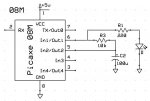I am using pulsin to watch for a pulse of a specific width to appear on an input. The software then goes and does its thing. This pulse will come from a dumb RF receiver so a lot of noise is present so the current software is continuously waiting for this specific pulse width and rejecting other widths. This software is working, no problems.
I would like to slowly blink an LED so that I know that the system is powered and the micro is operating, a type of watchdog indicator. I do not know if it is possible to count or make a slow oscillator in the background but if it can be done, could someone give me a tip on how to do this.
I would like to slowly blink an LED so that I know that the system is powered and the micro is operating, a type of watchdog indicator. I do not know if it is possible to count or make a slow oscillator in the background but if it can be done, could someone give me a tip on how to do this.

